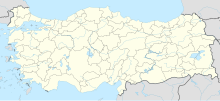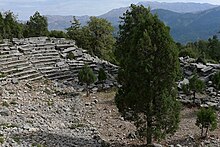Oinoanda
Coordinates: 36 ° 49 ' N , 29 ° 33' E
Oinoanda ( Greek Οἰνόανδα , Luwian Wiyanawanda) is an ancient city in Lycia above the northern end of the Xanthos Valley.
topography
Oinoanda is not developed for tourism; It cannot be reached by car, but only on foot via a narrow, steep path (or a dry stream bed) and is located on a ridge about 120 meters above the small village Incealiler on the D350 Antalya - Fethiye in the province of Muğla in Turkey. The walk takes 50 to 60 minutes; heavy rain can cause significant problems.
Although Oinoanda has been increasingly intensively researched scientifically in recent years, the ruins have not been “cleared up” in contrast to many other ancient places in today's Turkey. The city area itself is still easy to walk through, but you have to watch out for loose rubble.
history
The place name is as Wiyanawanda ( Hittitsch wiyana "wine, vine") in Hittite documents in connection with a campaign against Awarna ( Xanthos ), a city of the Lukka countries . About the exact location of the early settlement of the 13th century BC BC, however, nothing else is known, neither through finds nor other sources.
The ancient city can only be traced back to the Hellenistic period (end of the 3rd / beginning of the 2nd century BC). With Kibyra , Bubon and Balboura , Oinoanda, now a Greek polis , joined forces in the 2nd century BC. BC to form a four-city alliance (Tetrapolis) , which was founded by the Roman general Lucius Licinius Murena in 84 BC. In the course of the fighting with Mithridates VI. was dissolved. Oinoanda then belonged to the Lycian league and with this became part of the province of Lycia et Pamphylia under Emperor Claudius .
In the Hellenistic period, colonists from the Pisidic Termessos were settled in Oinoanda , who apparently temporarily formed their own body within the Oinoanda polis ( Greek Τερμησσός ἡ μικρά “small termessos ”, Τερμησσεῖς “δἱ πρὸessier bei Oinoάς”). For a long time, Oinoanda was linked to the Polis Xanthos by intense rivalry and hostility, which also led to outbreaks of violence.
The city is best known among researchers for the discovery of several extensive inscriptions from Roman times: the Epicurean treatises by Diogenes of Oinoanda , the foundation of a festival by Demosthenes of Oinoanda (both 2nd century), the large genealogical inscription on the tomb of Licinnia Flavilla as well as a theological oracle from the late 3rd century.
In ancient times, a bridge crossed the Xanthos River ( bridge at Oinoanda ) at the foot of the city hill . In late antiquity the city was the seat of a bishop; The titular Oenoanda of the Roman Catholic Church goes back to the diocese .
literature
- Allan Hall: The Oenoanda survey, 1974-76 . In: Anatolian Studies . tape 26 , 1976, p. 191-197 .
- Allan Hall: A sanctuary of Leto at Oenoanda . In: Anatolian Studies . tape 27 , 1977, pp. 193-197 .
- Roger Ling, Allan Hall: Building Mk1 at Oenoanda . In: Anatolian Studies . tape 31 , 1981, pp. 31-53 .
- John J. Coulton: Oinoanda. The Doric building (Mk 2) . In: Anatolian Studies . tape 32 , 1982, pp. 45-59 .
- John J. Coulton: Termessians at Oinoanda . In: Anatolian Studies . tape 32 , 1982, pp. 115-131 .
- John J. Coulton: The buildings of Oinoanda . In: Proceedings of the Cambridge Philological Society . tape 209 , 1983, pp. 1-20 .
- John J. Coulton: Oinoanda. The agora . In: Anatolian Studies . tape 36 , 1986, pp. 61-90 .
- EC Stenton, John J. Coulton: Oinoanda. The Water Supply and Aqueduct . In: Anatolian Studies . tape 36 , 1986, pp. 15-59 .
- Michael Wörrle: City and Festival in Imperial Asia Minor. Studies on an agonistic foundation from Oinoanda (= Vestigia. Volume 39 ). Munich 1988.
- Nicholas P. Milner, Stephen Mitchell: An exedra for Demosthenes of Oenoanda and his relatives . In: Anatolian Studies . tape 45 , 1995, pp. 91-104 .
- John J. Coulton, Nicholas P. Milner, Allan S. Hall: The mausoleum of Licinnia Flavilla and Flavianus Diogenes of Oinoanda. Epigraphy and architecture . In: Anatolian Studies . tape 46 , 1996, pp. 111-144 .
- Nicholas P. Milner: A Roman bridge at Oinoanda . In: Anatolian Studies . tape 48 , 1998, pp. 117-123 .
- Christof Schuler: Termessos [2]. In: The New Pauly (DNP). Volume 12/1, Metzler, Stuttgart 2002, ISBN 3-476-01482-7 , Sp. 159.
- Nicholas P. Milner: Ancient inscriptions and monuments from the territory of Oinoanda . In: Anatolian Studies . tape 54 , 2004, pp. 47-77 .
- Hansgerd Hellenkemper , Friedrich Hild : Lykia and Pamphylia (= Tabula Imperii Byzantini . Volume 8 ). Vienna 2004, ISBN 3-7001-3280-8 , p. 750-754 .
Web links
- German Archaeological Institute: Oinoanda and the largest inscription in the ancient world
- map
- Photos
- Coins of Oinoanda
- Description, pictures and plans of Oinoanda in Lycia
Remarks
- ^ Max Gander: The geographic relations of the Lukka countries . Texts of the Hittites, issue 27 (2010). ISBN 978-3-8253-5809-9 . P. 6
- ^ L. Zgusta: Kleinasiatische Ortnames , Heidelberg 1984, p. 432.



